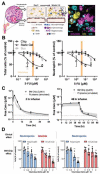Is it Time for Reviewer 3 to Request Human Organ Chip Experiments Instead of Animal Validation Studies?
- PMID: 33240763
- PMCID: PMC7675190
- DOI: 10.1002/advs.202002030
Is it Time for Reviewer 3 to Request Human Organ Chip Experiments Instead of Animal Validation Studies?
Abstract
For the past century, experimental data obtained from animal studies have been required by reviewers of scientific articles and grant applications to validate the physiological relevance of in vitro results. At the same time, pharmaceutical researchers and regulatory agencies recognize that results from preclinical animal models frequently fail to predict drug responses in humans. This Progress Report reviews recent advances in human organ-on-a-chip (Organ Chip) microfluidic culture technology, both with single Organ Chips and fluidically coupled human "Body-on-Chips" platforms, which demonstrate their ability to recapitulate human physiology and disease states, as well as human patient responses to clinically relevant drug pharmacokinetic exposures, with higher fidelity than other in vitro models or animal studies. These findings raise the question of whether continuing to require results of animal testing for publication or grant funding still makes scientific or ethical sense, and if more physiologically relevant human Organ Chip models might better serve this purpose. This issue is addressed in this article in context of the history of the field, and advantages and disadvantages of Organ Chip approaches versus animal models are discussed that should be considered by the wider research community.
Keywords: microfluidics; microphysiological systems; organoids; organ‐on‐a‐chip; preclinical studies.
© 2020 The Authors. Published by Wiley‐VCH GmbH.
Conflict of interest statement
The author has the following potential conflicts: Emulate Inc., equity, consulting, chair of SAB; BOA Biomedical Inc., equity, consulting, chair of SAB, board member; Free Flow Medical Device, equity; SynDevRx, equity; Consortia Rx, equity, board member; Roche, consulting; Astrazeneca, sponsored research; Fulcrum Therapeutics, sponsored research; Kraft Heinz, sponsored research; and inventor of multiple patent applications.
Figures







References
-
- Meigs L., Smirnova L., Rovida C., Leist M., Hartung T., Altex 2018, 35, 275. - PubMed
-
- Seok J., Warren H. S., Cuenca A. G., Mindrinos M. N., Baker H. V., Xu W., Richards D. R., McDonald‐Smith G. P., Gao H., Hennessy L., Finnerty C. C., López C. M., Honari S., Moore E. E., Minei J. P., Cuschieri J., Bankey P. E., Johnson J. L., Sperry J., Nathens A. B., Billiar T. R., West M. A., Jeschke M. G., Klein M. B., Gamelli R. L., Gibran N. S., Brownstein B. H., Miller‐Graziano C., Calvano S. E., Mason P. H., et al., Proc. Natl. Acad. Sci. U. S. A. 2013, 110, 3507. - PMC - PubMed
Publication types
Grants and funding
LinkOut - more resources
Full Text Sources
Miscellaneous
